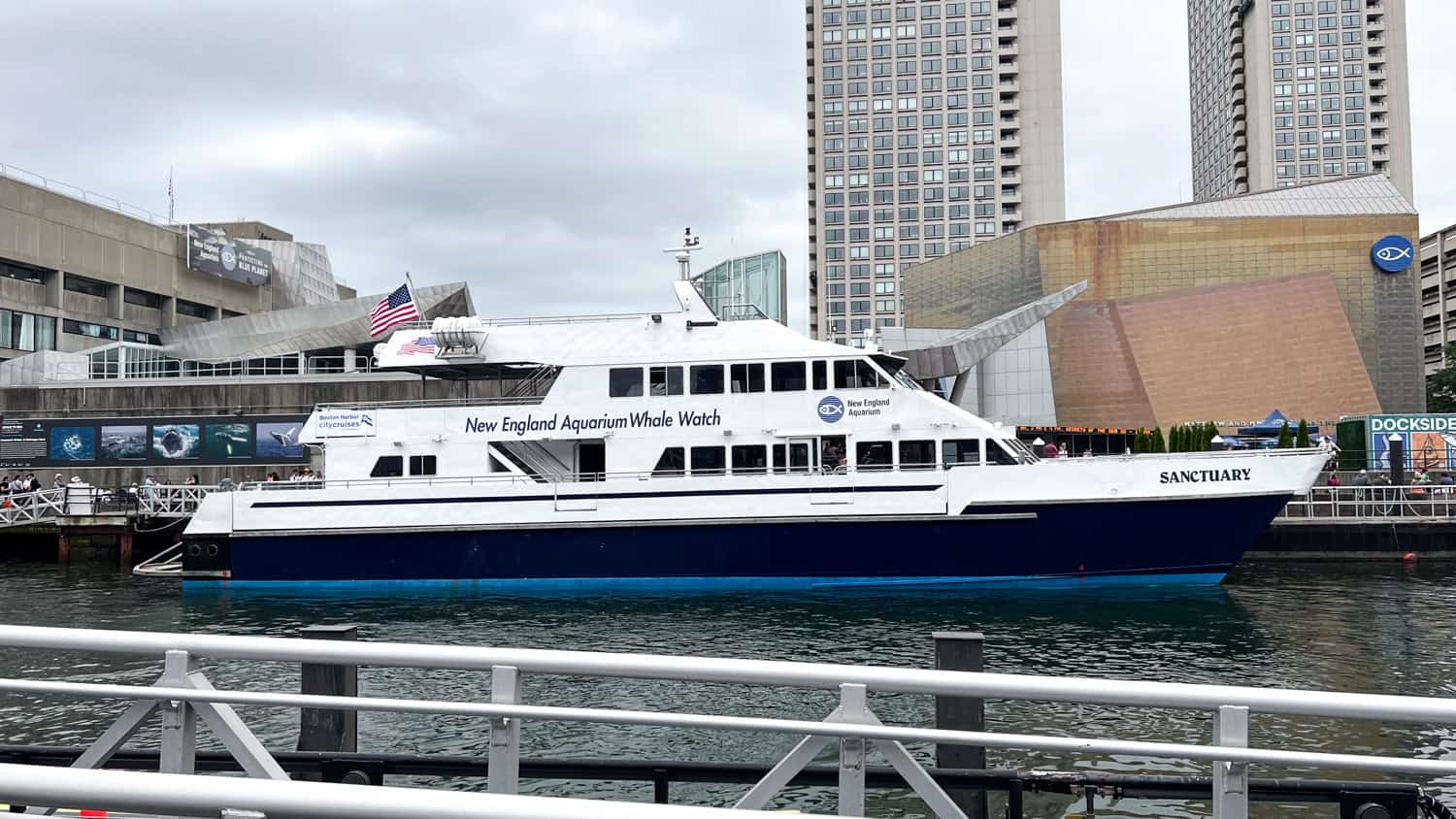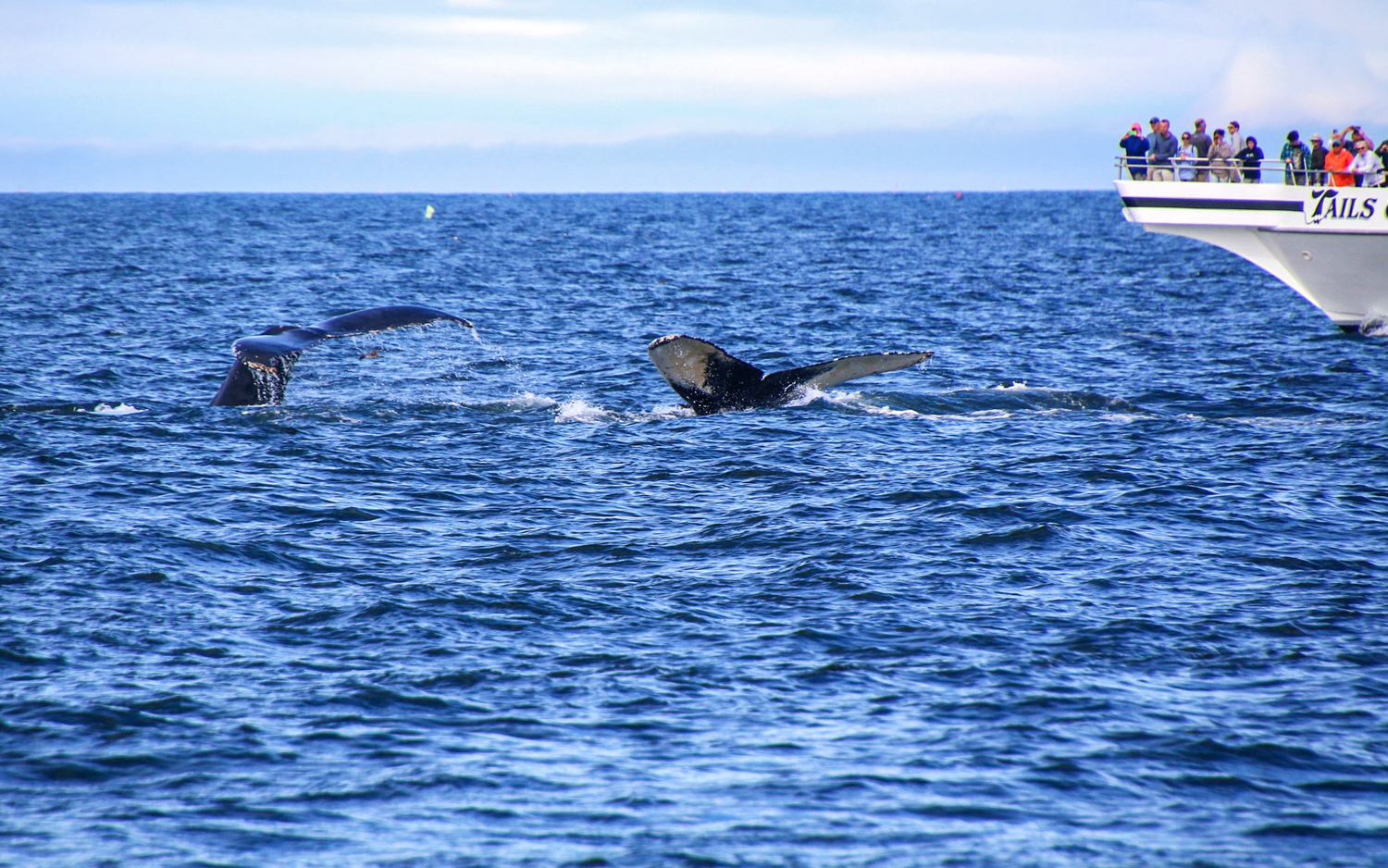The opportunity to see a friend get married in Boston led to one of the best whale-watching tours of my life. Based on previous excursions in Ecuador and Iceland, I had low expectations. But Boston beat them by a long shot, and I didn't even have to leave the United States.
In this post, I'll share my experience on a whale-watching catamaran cruise from Boston Harbor and some fun facts about the humpback, fin, and minke whales you can see.
Table of Contents
Whale Watching Tour
Boston Harbor

It was 2 p.m. on Monday, July 3, 2023, when Kel and I arrived at Long Wharf in Boston Harbor for our cruise. The day before, we'd attended my friend Kate McCulley's wedding in Boston Public Garden. And the day after, we planned to drive up the New England coast to Portland, Maine.
We booked the $74 per person tour through Get Your Guide's website. Their email confirmation instructed us to arrive 30 minutes before departure and to pick up physical tickets at the Boston Harbor City Cruises kiosk. Once those were collected, we got in the long line to board the Sanctuary, a New England Aquarium Whale-Watching vessel.
At 2:15 p.m., the boarding process began. I don't know how many hundreds of people these whale-watching boats can carry, but it's impressive to see everyone fit on board. I worried the capacity crowd would make it hard to get a good vantage point to see whales when the time came.
Our tour departed Long Wharf on time at 2:30 p.m. and puttered through calm Boston Harbor at a safe speed. As we made our way east out of the channel, planes could be seen landing at Boston Logan International Airport to the north. The sky was mostly cloudy.

Aboard Sanctuary
Whale watching tours from Boston travel east through Massachusetts Bay for about 21 miles to reach the Stellwagen Bank National Marine Sanctuary. The 842-square-mile reserve is between Cape Ann in Rockport, MA, to the north and Cape Cod to the south. The protected waters are considered part of the Gulf of Maine, the fastest-warming body of water on the planet due to global warming.
A few months earlier, I learned about the superheated waters of the Gulf of Maine on a lobster boat tour in Bar Harbor. The warm waters are causing lobsters to migrate north toward Canada, thereby threatening Maine's lobster industry.
During our trip to the marine reserve, I couldn't help but notice how loud the boat was. An app on my watch registered 75 decibels in the first-floor interior cabin and a very loud 90 db out back by the engines once we were traveling at full speed. Unfortunately, the rear is the best place to sit for passengers prone to seasickness. Bring earplugs if that may be you.
After 45 minutes of cruising, I could still see land and had some 5G cell coverage. We reached the reserve after 75 minutes and saw our first whales around 2:55 p.m. (85 minutes after departing Long Wharf).
Stellwagen Bank National Marine Sanctuary

The catamaran slowed as we entered an area with other tour boats and whales breaching the surface to breathe. We'd been instructed to look for the sprays of water from their blowholes, and we soon saw many. One of the guides on board began narrating the scenes, drawing our attention to whales based on their location relevant to the ship.
My concerns about having difficulty seeing the whales due to the crowd were unfounded. People lined the edges of all three decks, and while the ship felt full, it didn't feel overcrowded. I was also able to move from one deck to another.
The three kinds of whales you're likely to see when whale watching from Boston are humpback whales, fin whales (finback whales), and minke whales. Atlantic white-sided dolphins may also be seen along with them in these waters. While the majority of whales we saw were humpbacks, I'd like to introduce you to all three.


Humpback Whales
Humpback whales are the stars of the show on Boston whale watching tours. These magnificent creatures, known for their acrobatic displays and haunting songs, can grow to 60 feet long and weigh 40 tons. They can live 80 to 90 years.
During the tour, you might be lucky enough to witness their incredible behaviors, such as breaching, where they propel their massive bodies out of the water, or tail slapping, creating a thunderous splash. Humpbacks are known for their long migrations, traveling thousands of miles between their feeding grounds in the cold waters off Boston and their breeding grounds in warmer climates.
Fin Whales
Fin whales have been nicknamed the “greyhounds of the sea” due to their speed. These sleek and fast swimmers are the second-largest whale species (after blue whales), reaching lengths of up to 85 feet.
Fin whales are easily recognizable by their distinctive coloring, dark back and white underbelly, and a unique asymmetrical coloration on their lower jaw. They're often seen gracefully gliding through the water, occasionally showing their dorsal fin and blowing a tall spout of water into the air.
A week after this incredible whale watching tour out of Boston, I saw fin whales during a windjammer cruise in Maine. The chance to see these massive whales from the deck of a sailboat was extraordinary.
Minke Whales
Minke whales are the smallest and most elusive baleen whales you might encounter on a Boston whale watching tour. They typically measure 20 to 30 feet long and are known for their sleek, dark bodies and white underbellies.
Minke whales are often shy and quick, making them more challenging to spot. However, their curious nature sometimes brings them closer to boats, offering lucky observers a closer look. Despite their size, minke whales can be acrobatic, occasionally breaching or showing their graceful movements as they navigate through the waters of the North Atlantic.
Related: Snorkeling with Whale Sharks in Cancun


North Atlantic Right Whales
The 50-foot-long, 70-ton North Atlantic right whale also visits the Stellwagen Bank National Marine Sanctuary but is critically endangered. Boats are prohibited from approaching them, so whale-watching tours focus on the other three species that allow for close encounters.
Wrapping Up
We spent about 35 minutes in the presence of many whales, some of which came incredibly close to our vessel. The guide, speaking with us the whole time, sounded legitimately impressed by the numbers.
It's hard to know whether our experience was indicative of all July whale-watching trips or whether we were fortunate. Regardless, the tour set a new high mark for me regarding what to expect on a whale-watching tour.
By comparison, my low mark was set on a whale-watching trip from Reykjavik, Iceland. We didn't see any whales (only dolphins), though I was visiting at the tail end of the season (April to September).
Once we had spent time with the whales, the high-speed catamaran needed about 90 minutes to return to Long Wharf in Boston Harbor, where we disembarked. The tour lasted about 3.5 hours and aligned with what the companies advertised.
Dave is the Founder and Editor in Chief of Go Backpacking and Feastio. He's been to 66 countries and lived in Colombia and Peru. Read the full story of how he became a travel blogger.
Planning a trip? Go Backpacking recommends:
- G Adventures for small group tours.
- Hostelworld for booking hostels.
